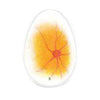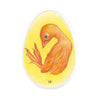
The Egg-ucated Chicken of Deer Run Farm presents,
"Chick Development Throughout Incubation".

Did you know that chick development begins even before the egg is laid? It’s true! Chick development starts as soon as the fertilization process occurs which is 24 hours before the egg is even laid. The first stage of chick development is the creation of a single cell (that’s called the zygote) that’s formed by the union of the egg and sperm cells of the parents. This cell will divide itself over and over again as the egg is being formed inside the hens 107 degree body. This group of cells is what makes up the blastoderm (or germinal disc) that can be seen on the surface of the yolk — you know, that white bullseye everyone tells you to look for to know if your eggs are fertilized or not?! Once the egg is laid and has a chance to cool the division of the cells stops. Although the chick is not developing at this time, as soon as the egg returns to the 99 degrees of an incubator or mother hen the cell division process will begin again.

The following is an in depth description of what’s happening inside the fertilized egg during incubation in terms of growth throughout the entire 21 day process.


 Day 3 of 21: The third day of incubation is the first day that, if candled, veins that have developed in the egg could very faintly be seen. These veins allow the embryo to access the nutrients in the egg from special membranes external to its body. The yolk sac, amnion, allantois and chorion are the four special membranesin the egg during chick development. Each membrane has a specific function to help provide for the embryo.
Day 3 of 21: The third day of incubation is the first day that, if candled, veins that have developed in the egg could very faintly be seen. These veins allow the embryo to access the nutrients in the egg from special membranes external to its body. The yolk sac, amnion, allantois and chorion are the four special membranesin the egg during chick development. Each membrane has a specific function to help provide for the embryo. Day 4 of 21: It’s not likely that there would be any visible difference from day 3’s development to day 4’s if the incubated eggs were candled. However, by the end of today the chicks will have begun to develop all of their organs needed to sustain life after hatching!
Day 4 of 21: It’s not likely that there would be any visible difference from day 3’s development to day 4’s if the incubated eggs were candled. However, by the end of today the chicks will have begun to develop all of their organs needed to sustain life after hatching!
 Day 5 of 21: By the end of today the embryo will have become a male or female as the reproductive organs start to develop. The chick’s bones will also begin to form today and within the next 24 hours both it’s legs and wings should be able to bend.
Day 5 of 21: By the end of today the embryo will have become a male or female as the reproductive organs start to develop. The chick’s bones will also begin to form today and within the next 24 hours both it’s legs and wings should be able to bend. Day 6 of 21: Voluntary movements of the embryo can begin to take place today. This is caused by the force of the embryo’s heartbeat that’s now beating at the rate of 260 to 280 beats per minute!
Day 6 of 21: Voluntary movements of the embryo can begin to take place today. This is caused by the force of the embryo’s heartbeat that’s now beating at the rate of 260 to 280 beats per minute! Day 7 of 21: The embryo will look more like a bird by the end of day 7. All the main parts of the chicken will be present; digits will begin to appear on the feet and grow into toes, feather germs will begin to form on the tail and thighs, the comb will start to develop and the egg tooth will start to grow. The heart will finally be completely enclosed in the thoracic cavity, whereas previously it had been on the outside of the embryo resting on the yolk sac.
Day 7 of 21: The embryo will look more like a bird by the end of day 7. All the main parts of the chicken will be present; digits will begin to appear on the feet and grow into toes, feather germs will begin to form on the tail and thighs, the comb will start to develop and the egg tooth will start to grow. The heart will finally be completely enclosed in the thoracic cavity, whereas previously it had been on the outside of the embryo resting on the yolk sac. Day 8 of 21: Day 8 marks the beginning of the second week of incubation for the embryo. If the embryo was examined closely it would appear to have an unusually large eye for the body that it is on. Unique to day 8 development is the forming of the nictating membrane which is actually the “third eyelid” of a chicken. This transparent membrane keeps the eye moist by moving across it. It’s purpose is to allow the bird to always be able to see even when it blinks!
Day 8 of 21: Day 8 marks the beginning of the second week of incubation for the embryo. If the embryo was examined closely it would appear to have an unusually large eye for the body that it is on. Unique to day 8 development is the forming of the nictating membrane which is actually the “third eyelid” of a chicken. This transparent membrane keeps the eye moist by moving across it. It’s purpose is to allow the bird to always be able to see even when it blinks! Day 9 of 21: As the embryo continues to grow larger today, the yolk takes a flatter form and the albumen separates into two layers that surround the top and bottom of the yolk. This helps to cushion the embryo while it becomes more and more active, moving around in the amniotic fluid.
Day 9 of 21: As the embryo continues to grow larger today, the yolk takes a flatter form and the albumen separates into two layers that surround the top and bottom of the yolk. This helps to cushion the embryo while it becomes more and more active, moving around in the amniotic fluid. Day 10 of 21: The embryo continues to grow larger and the facial features become more prominent throughout day 10 of incubation. In particular, the beak begins to harden more and more while the nose openings begin to grow and narrow. The chicks toes are now fully separated and have started to grow toenails as well.
Day 10 of 21: The embryo continues to grow larger and the facial features become more prominent throughout day 10 of incubation. In particular, the beak begins to harden more and more while the nose openings begin to grow and narrow. The chicks toes are now fully separated and have started to grow toenails as well. Day 11 of 21: Today is officially the half way point of incubation! The chick’s comb will develop a serrated edge, legs will develop scales, tail feathers will become apparent, toes will begin to curl and the aorta (the main blood vessel in the chick - just like us humans have) will be visible along the neck today.
Day 11 of 21: Today is officially the half way point of incubation! The chick’s comb will develop a serrated edge, legs will develop scales, tail feathers will become apparent, toes will begin to curl and the aorta (the main blood vessel in the chick - just like us humans have) will be visible along the neck today. Day 12 of 21: As the embryo continues to grow through day 12 of incubation, more sporadic movements can be seen if the egg were candled.
Day 12 of 21: As the embryo continues to grow through day 12 of incubation, more sporadic movements can be seen if the egg were candled. Day 13 of 21: The embryo continues to enlarge today. The skeleton is almost completely formed at this point in development. If you’ve ever used the wishbone of the chicken to make a wish — that bone is formed today. The left and the right collarbones merge together to form the wishbone.
Day 13 of 21: The embryo continues to enlarge today. The skeleton is almost completely formed at this point in development. If you’ve ever used the wishbone of the chicken to make a wish — that bone is formed today. The left and the right collarbones merge together to form the wishbone. Day 14 of 21: On the 14th day of incubation the embryo begins to position itself for hatching. It will turn its head towards the large end of the egg where the air cell is and its body will lay lengthways down the egg. The embryo will now have down everywhere and will soon completely cover the chick so that it will be ready for hatch.
Day 14 of 21: On the 14th day of incubation the embryo begins to position itself for hatching. It will turn its head towards the large end of the egg where the air cell is and its body will lay lengthways down the egg. The embryo will now have down everywhere and will soon completely cover the chick so that it will be ready for hatch. Day 15 of 21: From day 15 on, the incubation process is all about finalizing the embryo’s development. The bones, claws, skull and leg scales are all hardening today. The most important development of day 15 is the chick’s gut (the small intestine) is drawn into the abdominal cavity. Thus far it’s been outside of the body and on top of the yolk. This happens in preparation for the chick to be able to feed off the yolk when it hatches. Of course, there’s still more to happen before the chick will get to that point.
Day 15 of 21: From day 15 on, the incubation process is all about finalizing the embryo’s development. The bones, claws, skull and leg scales are all hardening today. The most important development of day 15 is the chick’s gut (the small intestine) is drawn into the abdominal cavity. Thus far it’s been outside of the body and on top of the yolk. This happens in preparation for the chick to be able to feed off the yolk when it hatches. Of course, there’s still more to happen before the chick will get to that point. Day 16 of 21: The albumen, or white of the egg, is just about gone by day 16 of incubation. Instead, the egg is mostly filled with the developed chick and it’s yolk that it will eventually use solely for it’s nutrients to survive the rest of incubation. The chick’s body is also now completely covered in down. It’s scales, claws and beak are also further hardening.
Day 16 of 21: The albumen, or white of the egg, is just about gone by day 16 of incubation. Instead, the egg is mostly filled with the developed chick and it’s yolk that it will eventually use solely for it’s nutrients to survive the rest of incubation. The chick’s body is also now completely covered in down. It’s scales, claws and beak are also further hardening.
 Day 18 of 21: Just one more day until “hatch lockdown” and 3 more days until hatch! There’s not too much to report on day 18. The chick will continue to enlarge today and it’s yolk will begin to be retracted into it’s body. The air cell at the large end of the egg will also continue to enlarge as we get closer to hatch. If candled today, most of the egg would be dark showing just how large the chick is with the remaining empty area being the air cell.
Day 18 of 21: Just one more day until “hatch lockdown” and 3 more days until hatch! There’s not too much to report on day 18. The chick will continue to enlarge today and it’s yolk will begin to be retracted into it’s body. The air cell at the large end of the egg will also continue to enlarge as we get closer to hatch. If candled today, most of the egg would be dark showing just how large the chick is with the remaining empty area being the air cell. Day 19 of 21: Today's development is just a continuation of the yolk being ingested by the chick. The chick will continue to take up more space in the egg while also slowly turning into position for hatch. At this point the chick’s head will be tucked under its right wing with it’s legs curled into it’s body.
Day 19 of 21: Today's development is just a continuation of the yolk being ingested by the chick. The chick will continue to take up more space in the egg while also slowly turning into position for hatch. At this point the chick’s head will be tucked under its right wing with it’s legs curled into it’s body. Day 20 of 21: The chick is in full preparation to begin to hatch. The yolk is still being absorbed today and is now about halfway inside the chick’s body. It needs to be completely inside the body before the chick can hatch safely.
Day 20 of 21: The chick is in full preparation to begin to hatch. The yolk is still being absorbed today and is now about halfway inside the chick’s body. It needs to be completely inside the body before the chick can hatch safely. Day 21 of 21: Today the chick has fully absorbed it’s yolk sac and blood supply. It now has a belly button where it’s stomach closed after the absorption.
Day 21 of 21: Today the chick has fully absorbed it’s yolk sac and blood supply. It now has a belly button where it’s stomach closed after the absorption.

1 comment
This was great! Love layman’s terms, easy to grasp and understand. Thanks